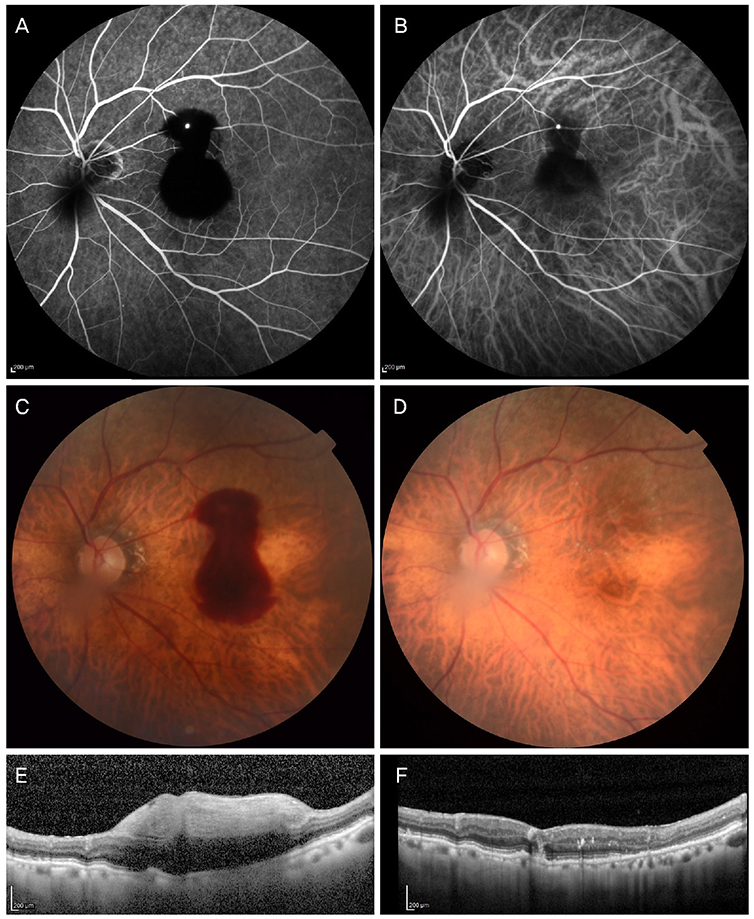J Korean Ophthalmol Soc.
2019 Apr;60(4):323-330. 10.3341/jkos.2019.60.4.323.
Bevacizumab Monotherapy for Macular Hemorrhage Secondary to a Retinal Arterial Macroaneurysm
- Affiliations
-
- 1Department of Ophthalmology, Chungbuk National University Hospital, Chungbuk National University College of Medicine, Cheongju, Korea. umlover9@gmail.com
- 2Department of Ophthalmology, Jeju National University Hospital, Jeju National University School of Medicine, Jeju, Korea.
- KMID: 2443148
- DOI: http://doi.org/10.3341/jkos.2019.60.4.323
Abstract
- PURPOSE
To evaluate the clinical features of intravitreal bevacizumab injection in patients with macular hemorrhage (submacular or subinternal limiting membrane hemorrhage) secondary to a retinal arterial macroaneurysm.
METHODS
We retrospectively reviewed the medical records of 17 eyes of 17 patients who underwent intravitreal bevacizumab injection with macular hemorrhage secondary to retinal arterial macroaneurysm. We evaluated the improvement of visual acuity and changes in central retinal thickness after intravitreal injections of bevacizumab. According to the final visual acuity, the characteristics of the good and poor visual prognoses groups were compared.
RESULTS
The mean age of patients (17 eyes) who underwent intravitreal bevacizumab treatment for macular hemorrhage secondary to retinal arterial macroaneurysm was 78.47 ± 7.84 years. The mean follow-up period was 3.99 ± 2.99 months, and the mean number of injections of bevacizumab was 2.12 ± 1.36. There were significant improvements in visual acuity and central retinal thickness, and the duration from symptom onset to treatment was shorter in patients with good visual prognoses.
CONCLUSIONS
Intravitreal bevacizumab injection alone was effective for improving visual acuity and decreasing central retinal thickness in patients with macular hemorrhage secondary to retinal arterial macroaneurysms.
MeSH Terms
Figure
Reference
-
1. Moosavi RA, Fong KC, Chopdar A. Retinal artery macroaneurysms: clinical and fluorescein angiographic features in 34 patients. Eye (Lond). 2006; 20:1011–1020.
Article2. Pitkänen L, Tommila P, Kaarniranta K, et al. Retinal arterial macroaneurysms. Acta Ophthalmol. 2014; 92:101–104.
Article3. Lavin MJ, Marsh RJ, Peart S, Rehman A. Retinal arterial macroaneurysms: a retrospective study of 40 patients. Br J Ophthalmol. 1987; 71:817–825.
Article4. Kim DH, Yu HG. Clinical results of vitrectomy in macular hemorrhage from a ruptured retinal artery macroaneurysm. J Korean Ophthalmol Soc. 2010; 51:961–966.
Article5. Moon SJ, Kim SW, Kim HS, et al. Intravitreal bevacizumab for macular edema secondary to ruptured retinal arterial macroaneurysm. J Korean Ophthalmol Soc. 2012; 53:522–527.
Article6. Ohno-Matsui K, Hayano M, Futagami S, et al. Spontaneous involution of a large retinal arterial macroaneurysm. Acta Ophthalmol Scand. 2000; 78:114–117.
Article7. Xu L, Wang Y, Jonas JB. Frequency of retinal macroaneurysms in adult Chinese: the Beijing Eye Study. Br J Ophthalmol. 2007; 91:840–841.
Article8. Brown DM, Sobol WM, Folk JC, Weingeist TA. Retinal arteriolar macroaneurysms: long-term visual outcome. Br J Ophthalmol. 1994; 78:534–538.
Article9. Tsujikawa A, Sakamoto A, Ota M, et al. Retinal structural changes associated with retinal arterial macroaneurysm examined with optical coherence tomography. Retina. 2009; 29:782–792.
Article10. Pichi F, Morara M, Torrazza C, et al. Intravitreal bevacizumab for macular complications from retinal arterial macroaneurysms. Am J Ophthalmol. 2013; 155:287–294.e1.
Article11. Battaglia Parodi M, Iacono P, Pierro L, et al. Subthreshold laser treatment versus threshold laser treatment for symptomatic retinal arterial macroaneurysm. Invest Ophthalmol Vis Sci. 2012; 53:1783–1786.
Article12. Parodi MB, Iacono P, Ravalico G, Bandello F. Subthreshold laser treatment for retinal arterial macroaneurysm. Br J Ophthalmol. 2011; 95:534–538.
Article13. Cho HJ, Rhee TK, Kim HS, et al. Intravitreal bevacizumab for symptomatic retinal arterial macroaneurysm. Am J Ophthalmol. 2013; 155:898–904.
Article14. Mansour AM, Foster RE, Gallego-Pinazo R, et al. Intravitreal anti-vascular endothelial growth factor injections for exudative retinal arterial macroaneurysms. Retina. 2018; 03. 02. DOI: 10.1097/IAE.0000000000002131. [Epub ahead of print].
Article15. Chanana B, Azad RV. Intravitreal bevacizumab for macular edema secondary to retinal macroaneurysm. Eye (Lond). 2009; 23:493–494.
Article16. Zweifel SA, Tönz MS, Pfenninger L, et al. Intravitreal anti-VEGF therapy for retinal macroaneurysm. Klin Monbl Augenheilkd. 2013; 230:392–395.
Article17. Cho HJ, Koh KM, Kim JH, et al. Intravitreal ranibizumab injections with and without pneumatic displacement for treating submacular hemorrhage secondary to neovascular age-related macular degeneration. Retina. 2015; 35:205–212.
Article
- Full Text Links
- Actions
-
Cited
- CITED
-
- Close
- Share
- Similar articles
-
- Intravitreal Bevacizumab for Macular Edema Secondary to Ruptured Retinal Arterial Macroaneurysm
- Ruptured Retinal Arterial Macroaneurysm after Panretinal Photocoagulation for Diabetic Retinopathy
- Full Thickness Macular Hole formation following Rupture of Retinal Arterial Macoraneur
- Treatment of Retinal Arterial Macroaneurysm
- Natural Visual Outcome of Submacular Hemorrhage Associated with Retinal Arterial Macroaneurysm



